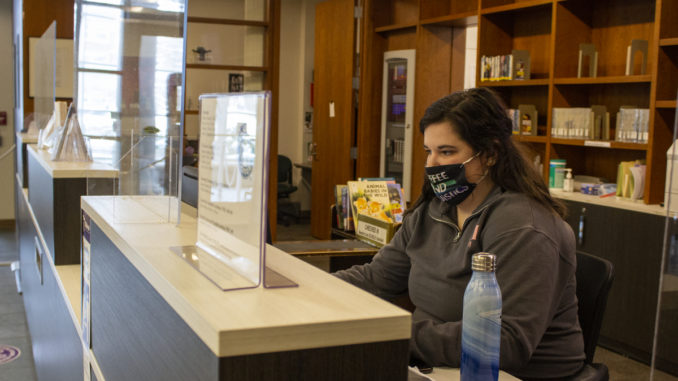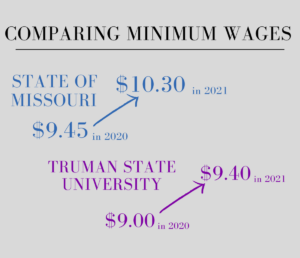
Truman State University has increased the minimum wage for students to $9.40 for the spring 2021 semester from fall 2020’s minimum wage of $9.00.
The rise of the student minimum wage at Truman has coincided with a rise in the Missouri minimum wage, which increased from $9.45 in 2020 to $10.30 in 2021. The rise in the state minimum wage is a part of the Missouri Proposition B or the $12 Minimum Wage Initiative, which will raise the Missouri minimum wage to $12 by 2023. This law, however, does not apply to state-owned institutions like Truman.
The gap between the state minimum wage and student wage has doubled, from $0.45 to $0.90. Some students, including senior business major Sam Mitchell, are unhappy with the increasing gap between these wages. Mitchell has worked on campus for institutional pay for two years and is currently employed by the IT department.
“I would definitely say that this is not fair for students, since for some students their only option is to work on campus, especially for international students,” Mitchell said.
Dave Rector, vice president for administration, finance and planning, explained that the raise that Truman decided on was voluntary, not state-mandated, and was based on the University budget. Some institutions did not raise the minimum wage for their students, he said, while others raised their wages above $9.40.
Missouri University of Science and Technology has a minimum wage of only $8.60 for bottom-tier employees, University of Missouri has a minimum wage of $9.45, and Missouri State University raised their student minimum wage to $10.30 as of Jan. 1, 2021. Like Truman, these universities have different tiers of employment so higher tiers of employees could earn more. At Truman, higher tier positions include lifeguards, building supervisors, art models and more.
Rector said the University wants to continue raising the student wages but will likely never reach state minimum wage because of budgeting limitations. Rector expressed that too high of a wage could potentially lead to fewer positions available for students.
Student wages can also vary if a student holds a position that requires more responsibility — such as lifeguards or building supervisors — but departments cannot raise their wage across their department. University Comptroller Michael Garzanelli said the reason for this is to have consistency across the University. Garzanelli also said students will not see a change in required scholarship hours.
Although the student minimum wage has increased, students who make $9.40 should not expect a higher taxable portion on their W2 documents, Garzanelli said.

